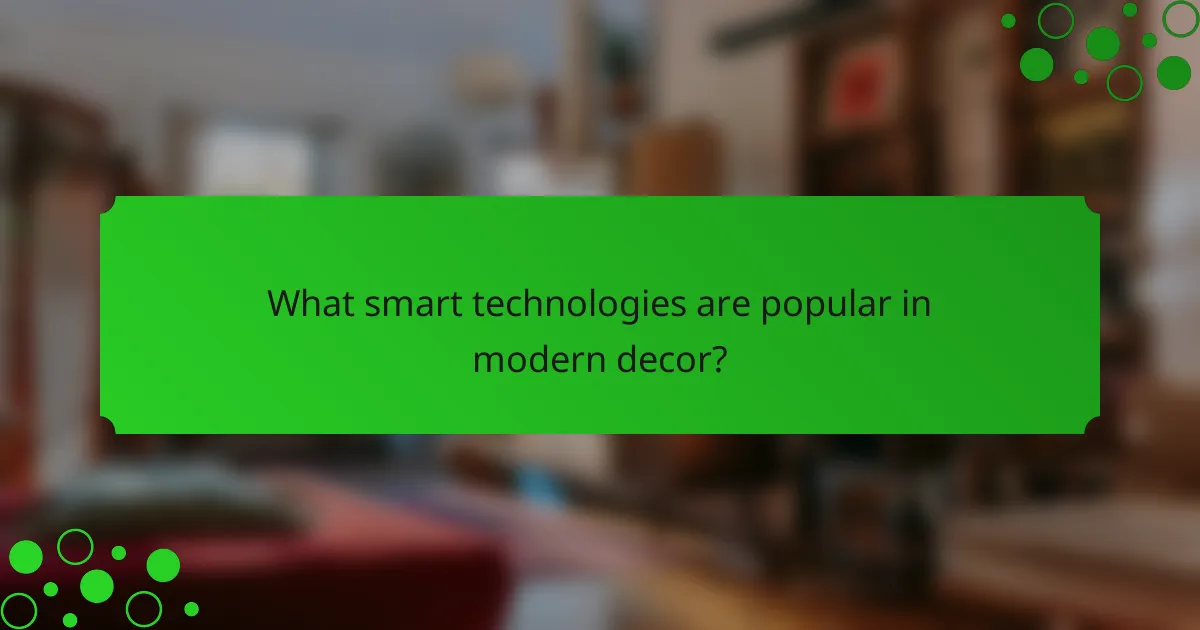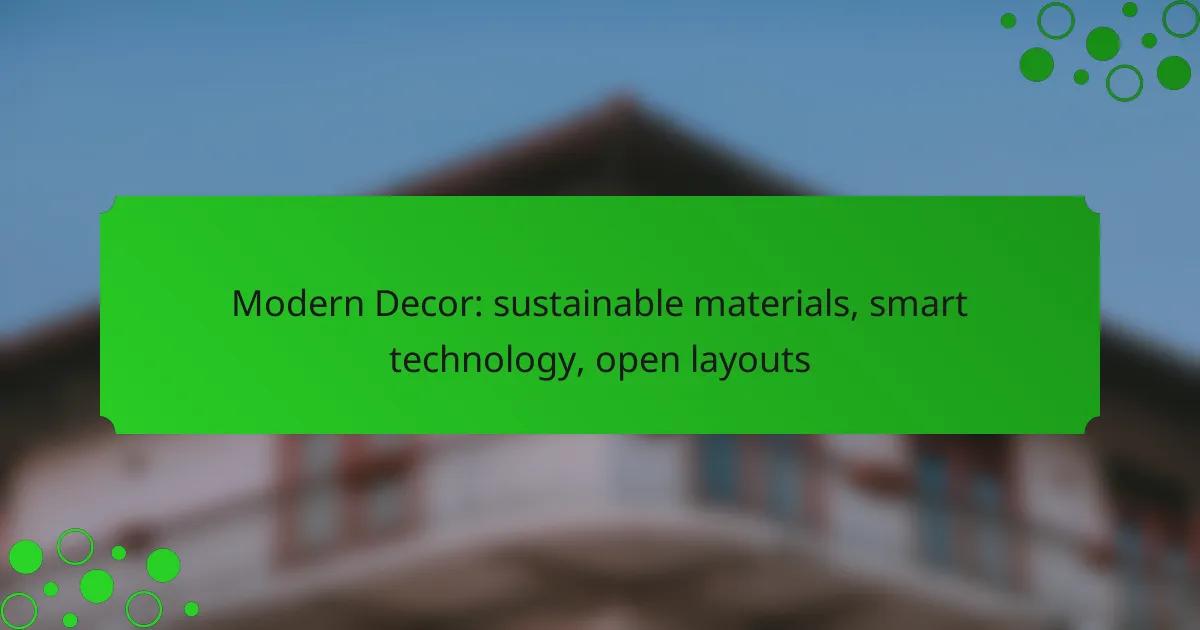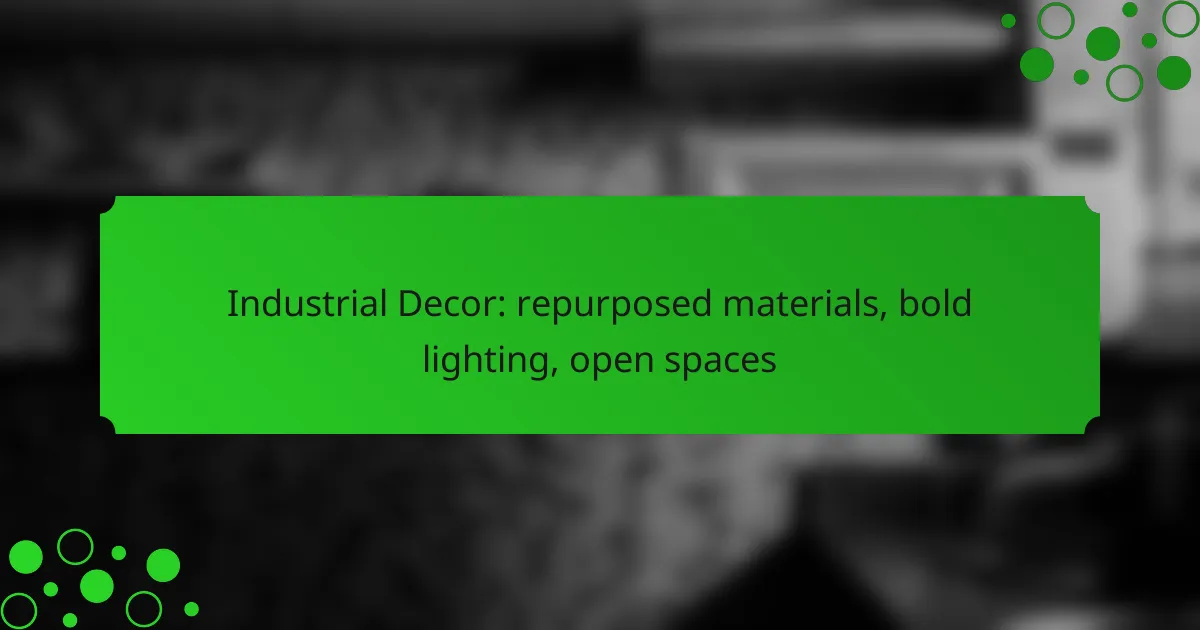Modern decor embraces a harmonious blend of sustainable materials, smart technology, and open layouts to create stylish and functional living spaces. By prioritizing eco-friendly options, integrating innovative technologies, and promoting seamless flow, contemporary design enhances both aesthetics and everyday convenience. This approach not only elevates the visual appeal but also fosters a more inviting and efficient home environment.

How can sustainable materials enhance modern decor?
Sustainable materials can significantly enhance modern decor by offering eco-friendly options that are both stylish and functional. These materials reduce environmental impact while providing durability and aesthetic appeal, making them ideal for contemporary living spaces.
Bamboo flooring
Bamboo flooring is a popular choice for modern decor due to its rapid growth and renewability. It is not only strong and durable but also offers a unique aesthetic that can complement various design styles.
When selecting bamboo flooring, consider the quality and source. Look for products that are certified by organizations like the Forest Stewardship Council (FSC) to ensure sustainability. Installation can be straightforward, often requiring minimal tools and expertise.
Recycled glass countertops
Recycled glass countertops provide a striking visual element while promoting sustainability. Made from post-consumer glass, these surfaces are available in a variety of colors and patterns, making them versatile for any kitchen or bathroom design.
These countertops are durable and resistant to stains and scratches, but they can be heavier than traditional materials, so proper support during installation is crucial. Additionally, consider the maintenance requirements, as some finishes may need periodic sealing.
Organic cotton textiles
Organic cotton textiles are an excellent choice for modern decor, offering softness and comfort without harmful chemicals. They are produced without synthetic pesticides or fertilizers, making them a healthier option for both the environment and your home.
When choosing organic cotton products, look for certifications like Global Organic Textile Standard (GOTS) to ensure authenticity. These textiles are available in various forms, including curtains, upholstery, and bedding, allowing for cohesive design throughout your space.
Low-VOC paints
Low-VOC paints are essential for maintaining indoor air quality while achieving vibrant colors in modern decor. VOCs, or volatile organic compounds, can contribute to health issues, so opting for low-VOC options helps create a safer living environment.
When selecting low-VOC paints, check labels for VOC content, aiming for products with less than 50 grams per liter for interior applications. These paints are available in a wide range of colors and finishes, ensuring you can find the perfect match for your decor style.

What smart technologies are popular in modern decor?
Smart technologies in modern decor enhance convenience and efficiency, integrating seamlessly into daily life. Popular options include smart lighting systems, thermostats, voice-controlled assistants, and automated window treatments, each offering unique benefits for contemporary living spaces.
Smart lighting systems
Smart lighting systems allow users to control lights remotely via smartphone apps or voice commands. These systems often include features like dimming, color changes, and scheduling, enabling homeowners to create the perfect ambiance for any occasion.
When selecting smart lighting, consider compatibility with existing fixtures and whether you prefer LED or traditional bulbs. Many systems can be integrated with home automation platforms, enhancing their functionality.
Smart thermostats
Smart thermostats optimize heating and cooling by learning user preferences and adjusting settings automatically. They can be controlled remotely, allowing for energy savings by reducing heating or cooling when no one is home.
Look for models that offer energy usage reports and compatibility with various HVAC systems. Many smart thermostats can also integrate with smart home ecosystems, providing a cohesive user experience.
Voice-controlled assistants
Voice-controlled assistants, such as Amazon Alexa or Google Assistant, serve as central hubs for managing smart home devices. Users can issue commands to control lighting, temperature, and even entertainment systems through simple voice prompts.
When choosing a voice assistant, consider the range of compatible devices and the ease of use. Ensure that the assistant supports your preferred smart technologies for a streamlined experience.
Automated window treatments
Automated window treatments offer convenience and energy efficiency by allowing users to open or close blinds and shades remotely or on a schedule. These systems can help regulate indoor temperatures and enhance privacy with minimal effort.
When selecting automated treatments, consider the type of window coverings that suit your decor and the power source required, whether battery-operated or hardwired. Look for options that integrate with other smart home technologies for maximum functionality.

How do open layouts improve living spaces?
Open layouts enhance living spaces by creating a seamless flow between areas, making them feel larger and more inviting. This design approach encourages interaction and maximizes natural light, contributing to a more enjoyable and functional environment.
Enhanced natural light
Open layouts allow natural light to penetrate deeper into the living space, reducing the need for artificial lighting during the day. By minimizing walls and barriers, sunlight can illuminate multiple areas simultaneously, creating a warm and inviting atmosphere.
Consider using large windows or glass doors to further enhance this effect. Skylights can also be an excellent addition, especially in spaces where wall openings are limited.
Improved flow and accessibility
With fewer walls, open layouts promote better flow and accessibility throughout the home. This design makes it easier to move between rooms, which is particularly beneficial for families or those who entertain frequently.
When designing an open space, ensure that pathways are clear and unobstructed. Avoid placing furniture in a way that disrupts movement, and consider using area rugs to define different zones without closing off the space.
Flexible furniture arrangements
Open layouts provide the flexibility to rearrange furniture easily, allowing homeowners to adapt their spaces to different needs or occasions. This adaptability can be particularly useful for hosting gatherings or creating distinct functional areas.
When selecting furniture, opt for pieces that can serve multiple purposes, such as ottomans that double as storage or extendable dining tables. This approach maximizes the utility of the space while maintaining a cohesive look.
Increased social interaction
Open layouts foster increased social interaction by eliminating barriers between living areas. This design encourages family members and guests to engage more freely, enhancing the overall sense of community within the home.
To further promote interaction, consider incorporating a central gathering space, such as a kitchen island or a large coffee table. These focal points can serve as natural meeting areas, making it easier for people to connect and converse.

What are the key considerations for choosing sustainable materials?
When selecting sustainable materials for modern decor, focus on their durability, environmental impact, and cost-effectiveness. These factors ensure that your choices contribute positively to both your living space and the planet.
Durability and lifespan
Durability is crucial when choosing sustainable materials, as longer-lasting products reduce the need for frequent replacements. Look for materials that can withstand wear and tear, such as bamboo, reclaimed wood, or recycled metals.
Consider the lifespan of the materials you select. High-quality sustainable options often last decades, minimizing waste and the environmental footprint associated with manufacturing new items.
Environmental impact
The environmental impact of materials encompasses their sourcing, production, and disposal. Opt for materials that are harvested responsibly, such as FSC-certified wood or organic textiles, which help preserve ecosystems.
Additionally, consider the carbon footprint associated with transporting materials. Local sourcing can significantly reduce emissions, making it a more sustainable choice for your decor.
Cost-effectiveness
Cost-effectiveness in sustainable materials often involves a higher initial investment but can lead to savings over time. Durable materials typically require less maintenance and replacement, making them more economical in the long run.
When budgeting, factor in potential energy savings from using materials that improve insulation or reduce energy consumption. For instance, using recycled insulation can lower heating and cooling costs, providing a return on investment.

How to integrate smart technology into modern decor?
Integrating smart technology into modern decor involves selecting devices that enhance functionality while complementing your aesthetic. Focus on compatibility, user-friendliness, and energy efficiency to create a cohesive and sustainable living space.
Assessing compatibility with existing systems
Before adding smart technology, evaluate how new devices will work with your current systems. Check for compatibility with existing smart hubs or platforms, such as Google Home or Amazon Alexa, to ensure seamless integration.
Consider the communication protocols of devices, such as Wi-Fi, Zigbee, or Z-Wave. This will help avoid issues with connectivity and ensure that all components work together effectively.
Choosing user-friendly interfaces
Select smart devices that offer intuitive interfaces for ease of use. Look for products with mobile apps or voice control features that simplify operation, especially for family members who may not be tech-savvy.
Test the user experience before purchasing, either through demos or reviews, to ensure that the interface aligns with your lifestyle and preferences.
Prioritizing energy efficiency
When integrating smart technology, prioritize devices that enhance energy efficiency. Look for products with Energy Star ratings or similar certifications that indicate lower energy consumption.
Smart thermostats, LED lighting, and energy monitoring plugs can significantly reduce utility bills. Consider investing in these technologies to maximize savings while minimizing environmental impact.










